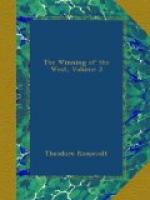Next day was spent by the army in completing the destruction of all the corn, the huts, and the belongings of the Indians. A band of a dozen warriors tried to harass one of the burning parties; but some of the mounted troops got on their flank, killed two and drove the others off, they themselves suffering no loss.
A Detachment Sent Back to Attack Indians.
The following day, the 21st, the army took up the line of march for Fort Washington, having destroyed six Indian towns, and an immense quantity of corn. But Hardin was very anxious to redeem himself by trying another stroke at the Indians, who, he rightly judged, would gather at their towns as soon as the troops left. Harmar also wished to revenge his losses, and to forestall any attempt of the Indians to harass his shaken and retreating forces. Accordingly that night he sent back against the towns a detachment of four hundred men, sixty of whom were regulars, and the rest picked militia. They were commanded by Major Wyllys, of the regulars. It was a capital mistake of Harmar’s to send off a mere detachment on such a business. He should have taken a force composed of all his regulars and the best of the militia, and led it in person.
This Detachment Roughly Handled.
The detachment marched soon after midnight, and reached the Miami at daybreak on October 22d. It was divided into three columns, which marched a few hundred yards apart, and were supposed to keep in touch with one another. The middle column was led by Wyllys in person, and included the regulars and a few militia. The rest of the militia composed the flank columns and marched under their own officers.
Immediately after crossing the Miami, and reaching the neighborhood of the town, Indians were seen. The columns were out of touch, and both of those on the flanks pressed forward against small parties of braves, whom they drove before them up the St. Joseph. Heedless of the orders they had received, the militia thus pressed forward, killing and scattering the small parties in their front and losing all connection with the middle column of regulars. Meanwhile the main body of the Indians gathered to assail this column, and overwhelmed it by numbers; whether they had led the militia away by accident or by design is not known. The regulars fought well and died hard, but they were completely cut off, and most of them, including their commander, were slain. A few escaped, and either fled back to camp or up the St. Joseph. Those who took the latter course met the militia returning and informed them of what had happened. Soon afterwards the victorious Indians themselves appeared, on the opposite side of the St. Joseph, and attempted to force their way across. But the militia were flushed by the easy triumph of the morning and fought well, repulsing the Indians and finally forcing them to withdraw. They then marched slowly back to the Miami towns, gathered their wounded, arrayed their ranks, and rejoined the main army. The Indians had suffered heavily, and were too dispirited, both by their loss, and by their last repulse, to attempt further to harass either this detachment or the main army itself on its retreat.




